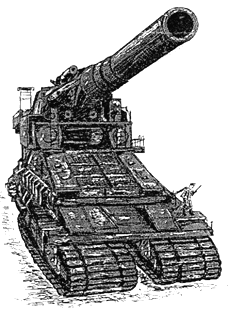80 cm cannon “Dora”
The 80 cm cannon “Dora” was the biggest gun which were ever built. There were some guns with a bigger caliber like the 91.4 cm Mallet mortar which was used during the Crimea war against Sevastopol and the American 91.4 mortar “Little David” (only one prototype) from the Second World War, but none gun had got such a big total mass like the Dora cannon. It weighed 1,350 tons and shot 7.1 tons Armor-piercing grenade over a distance of 38 km. The pipe weighed 400 t. In 1937 the company Krupp got the order to build this cannon from the Heereswaffenamt on own desire of Adolf Hitler. It was only used one time against Sevastopol in June 1942. Sevastopol was the strongest fortress of the world. Only 48 projectiles were shot with the Dora cannon. To used the cannon two pairs of tracks had to be build. To make it possible that the gun can fire in different directions a shooting curve had to build. To move the gun on this shooting curve two locomotives each with 691 kW were used. This cannon could not be transported in one piece and so it had be build up every time. To build up the tracks and the cannon over 2000 men and special cranes were needed and it took 6 weeks. Protection from air attacks was also very important. The Dora cannon should be primary used against the Maginot line between Germany and France. Another gun like this was built, but with another pipe. This gun was called “Schwerer Gustav” and it was never used. Another gun with the name “Langer Gustav” was also build, but it was not finished. There were even plans for a fourth gun called “Schwerer langer Gustav”. For these guns also rocket projectiles were planned, but they were not finished. They should fly up to 190 km. The incomplete “Langer Gustav” was destroyed by air attacks and “Dora” and “Schwerer Gustav” were blown up by a German blowing up command in Kummersdorf in 1945. The construction of these guns were very interesting, but the use was very low.

Technical data about the 80 cm cannon “Dora”
Type of weapon
Railway cannon
Manufacturer
Krupp
Caliber
80 cm
Total mass
1,350 t
Length
47.3 m
Width
7.1 m
Height
11.6 m
Ammunition
High-explosive grenade/Armor-piercing grenade
Projectile mass
-High-explosive grenade
-Armor-piercing grenade
4.8 t
7.1 t
Muzzle speed
-High-explosive grenade
-Armor-piercing grenade
820 m/s
720 m/s
Maximum range
-High-explosive grenade
-Armor-piercing grenade
48 km
38 km
Took this info off of a site.
For this and tons of other German cannons and tanks go to
http://www.die-legion.net/html/wwii_weapons.html[/img]






 , but we are actualy supposed to talk about Dora. The gun was a great thing and was very powerfull, but the thing is that it used so many man power to move, man and put together again.
, but we are actualy supposed to talk about Dora. The gun was a great thing and was very powerfull, but the thing is that it used so many man power to move, man and put together again.